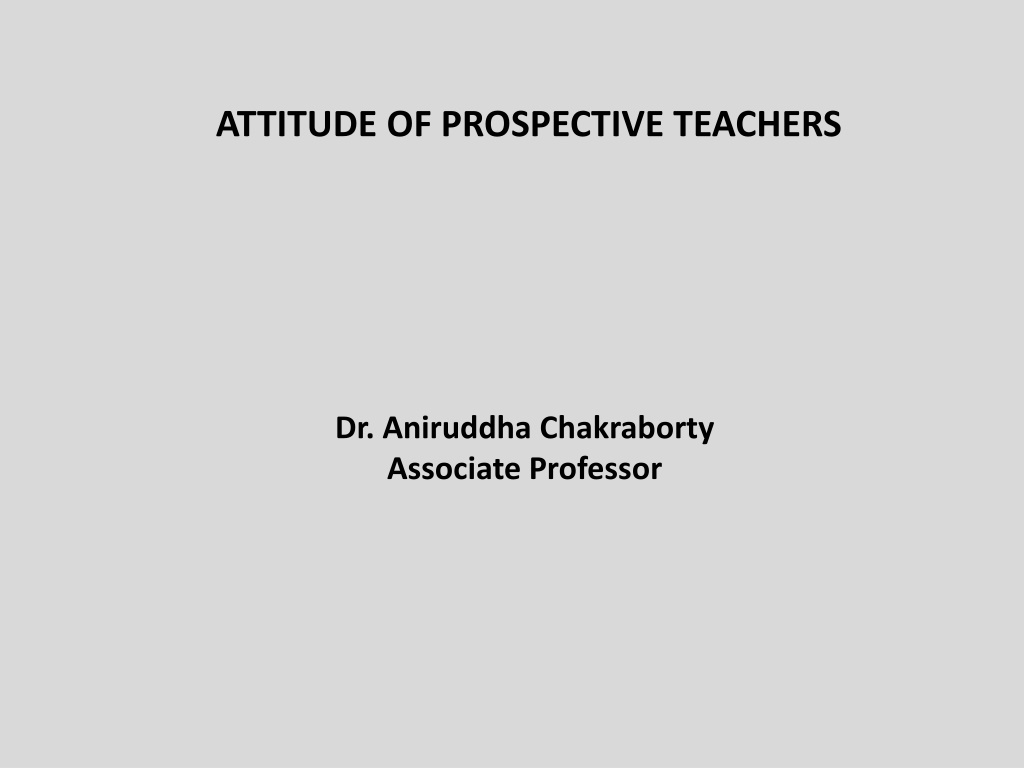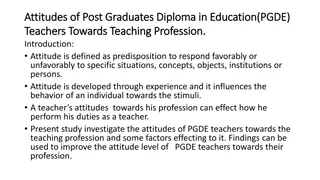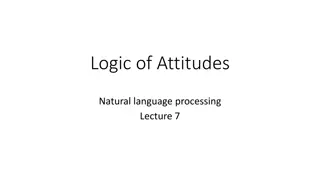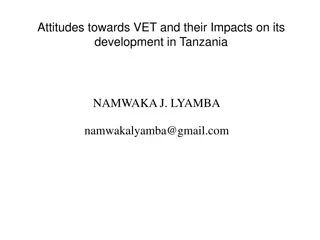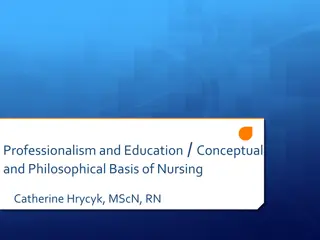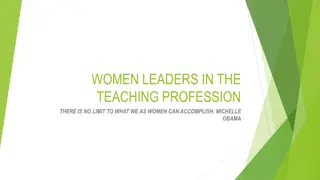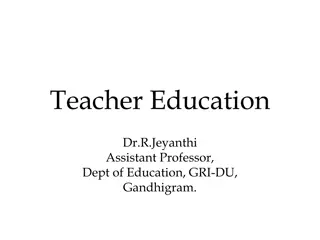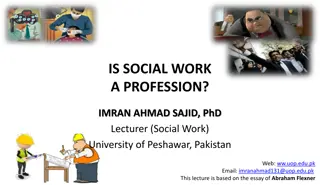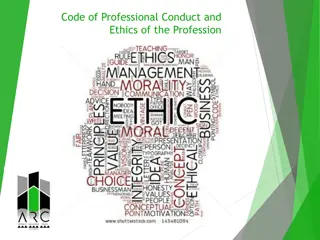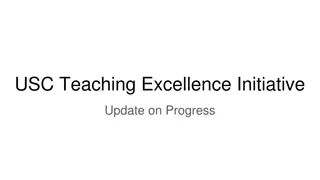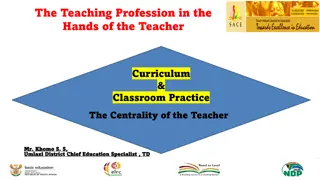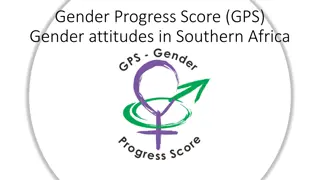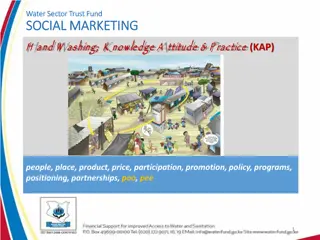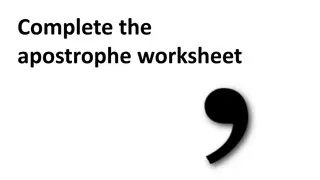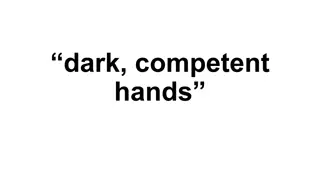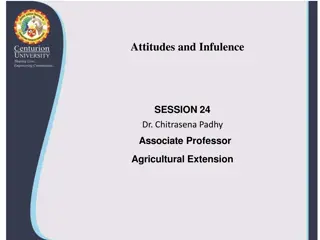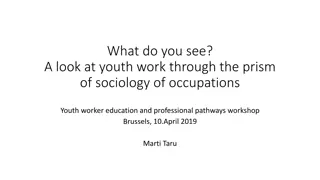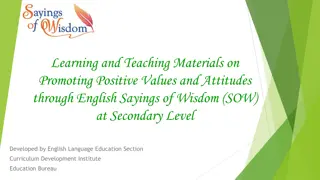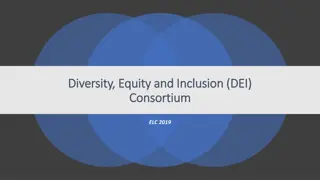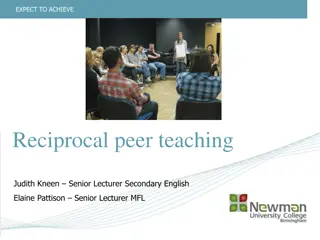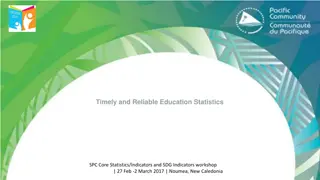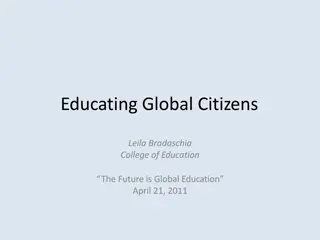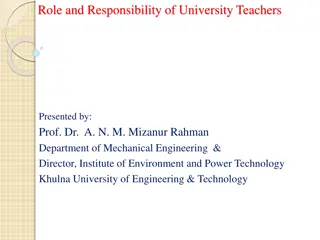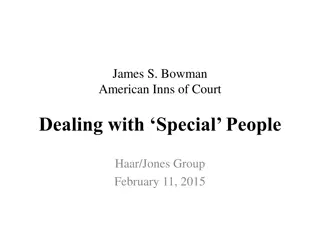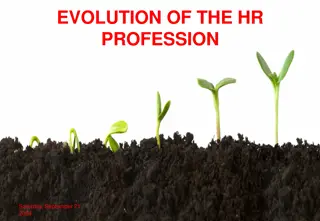The Impact of Attitudes on Teaching Profession in Contemporary Education
The changing nature of the teaching profession in the contemporary era has led to shifts in teachers' attitudes towards their work. Attitude is viewed as a state of preparation for action, affecting behavior and social interactions. Various scholars have defined and studied attitudes as internal states determining individual activities in the social world. Understanding and measuring attitudes are essential for effective teaching practices in heterogeneous classrooms envisioned by the RTE Act 2009.
Download Presentation

Please find below an Image/Link to download the presentation.
The content on the website is provided AS IS for your information and personal use only. It may not be sold, licensed, or shared on other websites without obtaining consent from the author. Download presentation by click this link. If you encounter any issues during the download, it is possible that the publisher has removed the file from their server.
E N D
Presentation Transcript
ATTITUDE OF PROSPECTIVE TEACHERS Dr. Aniruddha Chakraborty Associate Professor
Rte act 2009 and education RTE act 2009 envisages heterogeneous classrooms where all students have equitable access to grade appropriate and intellectually challenging curriculum, continuous and comprehensive evaluation, productive interactions with the teacher and equal status interactions with the peers. In such a classroom students display their skills, talents and understanding of the content.
So, there is a change in nature of teaching profession in respect to contemporary era Changing profession effects on the attitude towards teaching profession too pattern of teaching
ATTITUDE An internal state of preparation for action - Herbert Spencer and Alexander Bain . An attitude as the net affective feeling of a stimulus rather than as bodily orientation _ Thurston. Thomas' concept of attitude afforded him the subjective factor with which, together with the objective value, he sought to account for human social behaviour. Park used the attitude for a different purpose. He sought the ultimate social forces within each individual which would account for all human behaviour. He employed attitude as these ultimate units of analysis. Dewey built his social psychological scheme for the analysis of human behaviour upon three analytic tools: impulse, attitude and thought. Attitude organizes impulse in this scheme, and must be taken into account in order to understand human behaviour. Bain employed the attitude to refer to a particular kind of overt behaviour.
A person's attitude is the relatively stable overt behaviour which affects his status (Bain, 1928) An attitude is "a process of individual consciousness which determines real or possible activity of the individual in the social world" (Thomas and Znaniecki, 1927) an attitude is a psychological tendency that is expressed by evaluating a particular entity with some degree of favour or disfavour . [Eagly, A. H., & Chaiken, S. (1993) An attitude can be defined as a psychological tendency to view a particular object or behaviour with a degree of favour or disfavour . (Albarracin, 2005) An attitude is "a relatively enduring organization of beliefs, feelings, and behavioural tendencies towards socially significant objects, groups, events or symbols" (Hogg and Vaughan, 2005) Attitudes are the evaluative judgments that integrate and summarize . . . cognitive/affective reactions (Crano and Prislin, 2006)
Guidelines measurement (Henerson, Morris & Fitz-Gibbon, 1987) for attitude Scales Thurstone scale Likert scale Semantic differential Guttman scale Identify construct Measuring construct Construct an attitude measure Conduct a pilot study Revise tests for use Summarize, analyze, and display results
EMOTIONAL INTELLIGENCE "the subset of social intelligence that involves the ability to monitor one's own and others' feelings and emotions, to discriminate among them and to use this information to guide one's thinking and actions" (Salovey and Mayer, 1990) "managing feelings so that they are expressed appropriately and effectively, enabling people to work together smoothly toward their common goals." (Goleman , 1995) Mayer and Salovey (2000) proposed a model that identified four different factors of emotional intelligence: the perception of emotion, the ability reason using emotions, the ability to understand emotion and the ability to manage emotions.
Dimensions Self-motivation Achievement drive Commitment Initiative Optimism Self-awareness Emotional awareness, Self-confidence Self-regulation Self-control Trustworthiness Conscientiousness Adaptability Innovation Social skills Influence Communication Leadership, Change catalyst Conflict management Building bonds Collaboration and cooperation Team capabilities Empathy Service orientation Developing others Leveraging diversity Political awareness
Emotional Intelligence Scales Goleman's Emotional Intelligence Test written for Utne Magazine Trait Meta Mood Scale BarOn Emotional Quotient Inventory Schutte Emotional Intelligence Scale Multifactor Emotional Intelligence Scale Emotional Competence Inventory Emotional Intelligence Self Regulation Scale Tapia Emotional Intelligence Inventory Emotional Intelligence Scale Mayer-Salovey-Caruso-Emotional Intelligence test (MSCEIT) (Mayer et. al. 2003) Genos Emotional Intelligent scale (Gignac, 2010)
PERSONALITY personality is a dynamic organization within the individual of those psychophysical systems that determine her/his unique adjustment to her/his environment . (Allport, 1948) anindividual s personality then is his unique patterns of traits ----- A trait is any distinguishable, relatively enduring way in which an individual differs from another . (Guilford , 1959) personality is that which permits a prediction of what a person will do in a given situation . (Cattell , 1950) personality as more or less stable and enduring organization of a person s character, temperament, intellect and physique that determines person s unique adjustment to the environment . (Eysenk, 1971)
One basic truth is that individual is unique and it is product of its own functioning. Common element of most definitions is that they stress need to understand the meaning of individual differences. Personality is what makes an individual unique.
Measuring Personality Bell s Adjustment Inventory Minnesota Multiphase Personality Inventory (MMPI) Cattell s 16 Personality Factor Questionnaire Edwards Personal Preference Schedule (EPPS) Big Five Inventory
Operational definitions of the terms Prospective teachers are the All B.Ed. Trainees of the Teacher Education Institution of West Bengal. Attitudes towards teaching profession is assessed in term of high, average or low by self constructed scale score. Emotional intelligence of prospective teachers is assessed in term of high, average or low by self constructed EI scale score. Scores on Big Five Inventory questionnaire, with a high score indication a more favourable personality trait and a low score indicating a less favourable personality trait of prospective teachers. Gender is represented as male and female prospective teachers. Relation means the effect of independent variables into dependent variables
Development ofInstrument Item Construction Expert Opinion Pilot Study Item Analysis Norm Selection Final form of the Scale Validity and Reliability Test
Components of Emotional Intelligence Scale Personal competencies determine how we manage ourselves. Social competencies determine how we handle relationship. Personal competencies are categorized under the dimensions namely; regulations and self-motivation self-awareness, self- social competencies are categorized under two dimensions namely; empathy and social skills.
Gender variable Finding shows that mean value female prospective teachers are 282.84 and mean value of male prospective teachers are 277.13. So the mean difference is in favour of female prospective teachers are 5.71. Also a significant difference exists among the male and female prospective teachers attitude towards teaching profession. So it is concluded that female prospective teachers have more favourable attitude towards teaching profession than their male counterpart. This finding can be interpreted as an indicator of the fact that compared to the past, the profession of teaching, especially at secondary school level, is gradually becoming a profession for females every passing day. Generally females are more sympathetic and caring to the children in respect to males due to their natural phenomenon. This attribute is also reflects on the present study.
Emotional Intelligence variable The mean value of high, average and low emotional intelligent prospective teachers attitude towards teaching profession are 280.13, 279.68 and 280.00 respectively. It implies that high emotional intelligent prospective teachers have somehow little bit more favourable attitude towards teaching profession. But it is not significant at all. The results shows that pair of three levels of emotional intelligent prospective teachers attitude do not differ significantly towards teaching profession.
Big five personality traits In the present study mean values of prospective teachers those who are belonging to the five different personality traits in relation to attitude towards teaching profession are found 289.15 for extroversion trait, 291.94 for agreeableness trait, 289.94 for conscientiousness trait, 277.81 for neurotic trait and 287.41 for openness trait. Arranging as per descending order in respect to mean values of the five different traits the sequence is as follows: agreeableness > conscientiousness > extroversion > openness > neuroticism. In the present study the prospective teachers are scored higher in comparison to agreeableness trait with neuroticism trait. It is also found from the statistical analysis of the collected data that the prospective teachers with the neuroticism personality traits have significant differences having with the other four personality traits in the direction of attitude towards teaching profession. That means prospective teachers having neuroticism personality trait show less favourable attitude towards teaching profession in comparison to other four personality traits.
References Akbaba, B. (2013). The Attitudes of Pre-Service Social Studies Teachers towards Teaching Profession and Their Self-Efficacy about Using Instruction Materials. Mevlana International Journal of Education , 3(2), pp 157-169. Allport, G. W. (1935). Attitudes. In C. A. Murchison (Ed.), A handbook of social psychology. Worcester, MA: Clark University Press, p 798. Allport, G. W. (1937). Personality: A psychological interpretation. New York: H. Holt and Company. Arumugam, G., and Prabakar, P. (2015). A Study on Attitude towards Teaching Profession of B.Ed., Students in Relation to Self Esteem. Indian Journal of applied science, 5(1), pp 149-151. Bain, R. (1928). An attitude on attitude research. Amer. J. Social., 33, pp 940-957. Bentea, C. C. (2015). Relationships between personality characteristics and attitude towards work in school teachers. Procedia - Social and Behavioral Sciences, 180, pp 1562 1568. Copy of the 1995 article: Goleman wrote for Utne Magazine from http://www.utne.com/interact/test_iq.html retrieved on 11.08.2015. Creswell, J. W. (2003). Research Design. Thousand Oaks: Sage Publications Print. Cronbach, L. J. (1964). Essentials of psychological testing. New York, Harper and Row. Eagly, A. H., and Chaiken, S. (1993). The psychology of attitudes. Orlando, FL: Harcourt Brace Jovanovich College Publishers, p 1. Edwards, A. l. (1957). Techniques of attitude scale construction. New York, Appleton-Century Crofts. Goleman, D. (1995). Emotional intelligence. New York: Bantam. Henerson, M., Morris, L., and Fitz-Gibbon, C. (1987). How to measure attitudes. Beverly Hills, CA: Sage, pp 1- 192. Mayer, J. D., Salovey, P., and Caruso, D. R. (2000). Models of emotional intelligence. In R. J. Sternberg (Ed.). Handbook of Intelligence. Cambridge, England: Cambridge University Press, pp 396-420. Pervin, L. A. (1994). A critical analysis of current trait theory. Psychological Inquiry, 5, pp 103-113. Thurstone, L. L. (1928). Attitudes can be measured. American Journal of Sociology, 33,pp 529-554.
